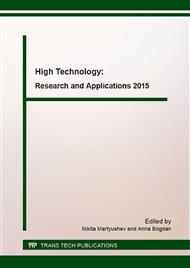p.408
p.413
p.417
p.422
p.427
p.432
p.436
p.441
p.445
Strength of Cutting Tool in Titanium Alloy Machining
Abstract:
In this paper, contact conditions between cutting tool and work material, strength of cutting tool are analyzed. Experimental and theoretical studies of contact load distribution on the artificial flank wear-land that appears on the cutter in a free orthogonal turning disk of titanium alloy (Ti-6Al-2Mo-2Cr) are described. Calculations of internal stresses by the method of finite elements show that for the sharp cutter the main stresses into cutting wedge near to the cutting edge are compression stresses, very large (10 000 MPa) and exceed ultimate compression stress for cemented carbide. Decreasing of main stress with appearance of wear on the flank explains ability working of cutter even at large wear on the flank. Increasing of cutter’s break off probability with appearance of large wear on the flank is explained by increasing of zone where the internal stresses are large enough (more or equal 3 000 MPa) and increasing of defects probability into this zone, which serves as source of cracks. Abbreviation and symbols: m/s – meter per second (cutting speed v); mm/r – millimeter per revolution (feed rate f); MPa – mega Pascal (specific contact load as stress σ or τ); hf – the width of the flank wear land (chamfer) of the cutting tool, flank wear land can be natural or artificial like in this paper [mm]; xh – distance from the cutting edge on the surface of the flank wear land [mm]; σh – normal specific contact load on the flank land [MPa]; τh – shear (tangential) specific contact load on the flank land [MPa]; HSS – high speed steel (material of cutting tool); Py r – radial component of cutting force on the rake face [N]; Pz – tangential component of cutting force [N]; γ – rake angle of the cutting tool [°]; α – clearance angle of the sharp cutting tool [°]; αh – clearance angle of the flank wear land [°]; b – width of a machined plate or disk [mm]; σ-UTS - ultimate compression stress [MPa]; σUTS - ultimate tensile stress [MPa].
Info:
Periodical:
Pages:
427-431
Citation:
Online since:
February 2016
Authors:
Price:
Сopyright:
© 2016 Trans Tech Publications Ltd. All Rights Reserved
Share:
Citation:


